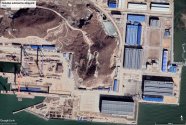sorry for the typo. Yasen class.The Laika class is inferior to the Tansen class. Just beacuse it came later on does mean that it is better.
You are using an out of date browser. It may not display this or other websites correctly.
You should upgrade or use an alternative browser.
You should upgrade or use an alternative browser.
09V/09VI (095/096) Nuclear Submarine Thread
- Thread starter Hendrik_2000
- Start date
There is no reason for China to import any wholesale platform from Russia. It goes without saying that China has numerous areas where it's ahead of Russia. And Russia has numerous area that it is ahead of China. I would think China can get help in certain part of nuclear submarine in exchange for drones/avionics technology to Russia. Without being involved, it would be hard for me to say which part of building modern nuclear submarine that China can learn from.
@tphuang more on exchange of ideas and maybe the most important the Sonar signature of the Collective West submarine. The Russian Navy is more experience in tracking opponent submarine than the Chinese.There is no reason for China to import any wholesale platform from Russia. It goes without saying that China has numerous areas where it's ahead of Russia. And Russia has numerous area that it is ahead of China. I would think China can get help in certain part of nuclear submarine in exchange for drones/avionics technology to Russia. Without being involved, it would be hard for me to say which part of building modern nuclear submarine that China can learn from.
Hydrodynamics, noise reduction i.e. stealth, propulsion.Without being involved, it would be hard for me to say which part of building modern nuclear submarine that China can learn from.
data. During the Cold War, due to weaker computational power Russia was far more hands on in experiments to get data, rather than use modeling. They didn't know how something worked? They just went for it.There is no reason for China to import any wholesale platform from Russia. It goes without saying that China has numerous areas where it's ahead of Russia. And Russia has numerous area that it is ahead of China. I would think China can get help in certain part of nuclear submarine in exchange for drones/avionics technology to Russia. Without being involved, it would be hard for me to say which part of building modern nuclear submarine that China can learn from.
this data is worth 100x more than any specific design or component and most of all, it is an already paid cost for Russia that doesn't compromise any existing systems. China can pay for data related to a specific experiment that answers a question that they have. They don't need to reveal the question, neither do the Russians, so it's secure. Just data.
This happens all the time in industry, btw. CROs (contract research organizations) sell experimental data to big companies so they don't have to do tedious or difficult experiments themselves.
@tphuang more on exchange of ideas and maybe the most important the Sonar signature of the Collective West submarine. The Russian Navy is more experience in tracking opponent submarine than the Chinese.
In theory this is correct. In practice such experience is of little practical value other than verifying China's own technological capabilities and their intelligence gathering in Russia.
First of all, submarines do not hunt other submarines. This is a misconception and a myth that was created by popular entertainment which used rumors and reports of such activity from USN and RN submarines during the cold war. That was factual and made possible because of the technological gap which gave western submarines advantages in silencing and sonar that wasn't closed until after the cold war.
As a result of this mismatch Soviet navy developed a number of solutions in the 70s and 80s, most importantly the so called "bastion strategy", which forced US and British SSNs to enter Soviet-controlled waters in the Arctic where Soviet navy would have land-based aviation and surface ASW assets to protect their SSBNs.
Soviet SSGNs were meant not for penetrating GIUK and attacking trans-Atlantic convoys as people reading Tom Clancy might imagine but for striking any NATO surface group approaching the boundary of the "bastion". Even then SSGNs were a secondary tool, after Naval Aviation which was responsible for the main strike. SSGNs would force the carrier air wing to react and split defenses between submarine and air-launched cruise missiles. Soviet SSGNs were also retained because of the technological mismatch because the range of cruise missiles was much greater than heavy torpedoes so using SSGNs was more effective than using SSNs.
Soviet SSNs had dual task of hunting enemy SSNs as well as surface assets. Soviet conventional subs played an important role in ambushes and protection of naval bases.
So if Soviet Navy had anything to teach PLAN it would be how to use geography to protect SSBNs and use large numbers of nuclear and conventional subs to deny entry of enemy carriers into the protected area. Considering China's geography it's not particularly valuable.
Soviet Navy has also been gone for 30 years and its successor - the Russian Navy - is incapable of countering the USN and has practically nothing to teach China in terms of tactics, experience and databases because it had no ability to exercise it in plausible conditions.
Just consider the dates of entry into service of modern Russian submarines:
- Severodvinsk (Pr. 885 / Yasen) entered service with Northern Fleet in Dec. 2013
- Kazan (Pr. 885M / Yasen M) - Northern Fleet, May 2021
- Novosibirsk (Pr. 885M / Yasen M) - Pacific Fleet, Dec. 2021
- Yuriy Dlogoruky (Pr. 955 / Borei) - Northern Fleet, Dec. 2012
- Aleksandr Nevsky (Pr. 955 / Borei) - Pacific Fleet, Dec. 2013
- Vladimir Monomakh (Pr. 955 / Borei) - Pacific Fleet, Dec. 2014
- Knyaz Vladimir (Pr. 955A / Borei) - Northern Fleet, Jun 2021
- Knyaz Oleg (Pr. 955A / Borei) - Pacific Fleet, Dec. 2021
Severodvinsk underwent extensive testing needed to develop 885M design and was not engaged in updating the knowledge of the Russian navy on hunting enemy warships and submarines. Yasen M ships with updated MGK-600 sonar complex have only been in service for a few months. These ships haven't been able to contribute meaningfully.
All the other submarines in active service with the Russian Navy are:
- Delta IV (Pr. 667 BDRM) SSBN - laid down 1981-87, commissioned 1984-90 and overhauled 2002-17 as a result of delays to Borei program
- Oscar II (Pr. 949A) SSGN - laid down 1985-91, commissioned 1988-96 and being currently overhauled (since 2013) as a result of delays to Yasen program
- Sierra II (Pr. 945A) SSN - laid down 1986-89, commisioned 1990-93, currently being overhauled
- Victor III (Pr. 671RMTK) SSN - laid down 1988-91, commisioned 1990-92, currently being overhauled
- Akula (Pr. 971) SSN - laid down 1986-93, commissioned 1988-95, currently being overhauled (majority in refit presently).
- Improved Akula (Pr. 971M) SSN - laid down 1991, commissioned 2001 (one submarine, K-335 "Gepard")
Yasen and Borei programs were intended for the 1990s and their entry into service was delayed by 20 years. They are not "modern" in the sense that Virginia Block IV/V is considered "modern". They are modern from the viewpoint of the Russian navy which has operated only one peer asset (971M) and 10-12 near peer assets (971) by cold war standards.
Soviet subs were never better than US or British subs. That was all propaganda, including US propaganda to expand spending. Soviets almost caught up in technological terms with 971M but never implemented fleet modernization due to economic reasons. When new designs entered service Russians were too busy re-learning the basics after two decades of skill erosion.
Consequently current Russian navy is as "capable" of modern naval warfare as its air force is capable of fighting modern offensive campaign in Ukraine. While Russian navy is not as technologically obsolete as the air force it is completely inadequate as a peer adversary both in terms of numbers and capabilities. If Russians were to share their databases with China where would they get them and with what tools?
So what can Russia do for China? My view is this:
1. It can provide hard data to verify design choices. Primary among those will be propulsion because nuclear technology and its practical aspects is probably the only field where Russia holds valuable information that could benefit China. Another is practical issues of maintenance of Russian designs. It is one thing to design a ship and another to use it extensively in intended conditions. Hydrodynamics or hydroacoustics can be resolved experimentally and through computer modelling of which China is obviously far more capable of than Russia. The limitations on current design was entirely in terms of production capacity - there's no point in designing a ship that you can't build. 09V won't be influenced by Russian technology because it's probably already in the works and Russian design in recent designs was trying to catch up with the west. Just like in aerospace there's something called evolutionary convergence where you simply don't have options if you want optimal performance. Furthermore from a production standpoint what is good for a series of 8 ships might not be good for a series of 20 or 30.
2. It can provide information on technology which might soon be on sale to India when economic warfare finally takes effect in the coming weeks and Russia is forced to seek financial aid through more aggressive exports. Such solution might be advantageous to China as having good information on Indian capability while having India assume that they gain an advantage by purchasing Russian tech, is better than India attempting to readjust its naval strategy when they acknowledge they've fallen behind the curve. It's better to help India play the superpower for a while and weaken ties with the US which should be easier following the Ukrainian conflict.
I don't think anything substantial in Chinese submarine design will be influenced by Russian design because I don't think Russian design has much to offer beyond what is covered by no. 1 above.
escobar
Brigadier
Sutton report
This is actually the older existing section of Huludao shipyard.
If they've shifted production to the new and larger section in the East, it would make sense to modernise the older facilities now
If you read the article at , they are using both old and new facilities right now.This is actually the older existing section of Huludao shipyard.
If they've shifted production to the new and larger section in the East, it would make sense to modernise the older facilities now


